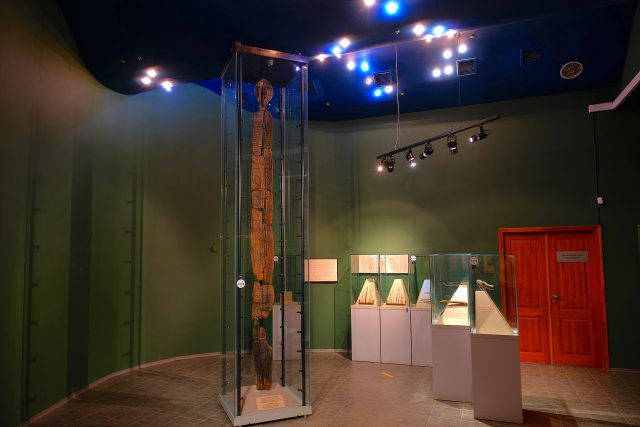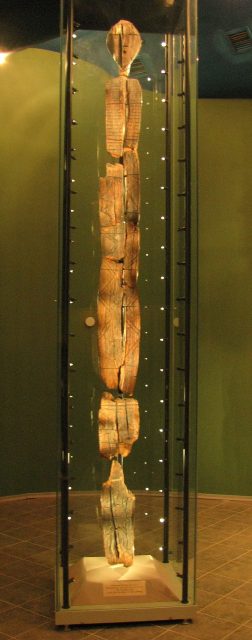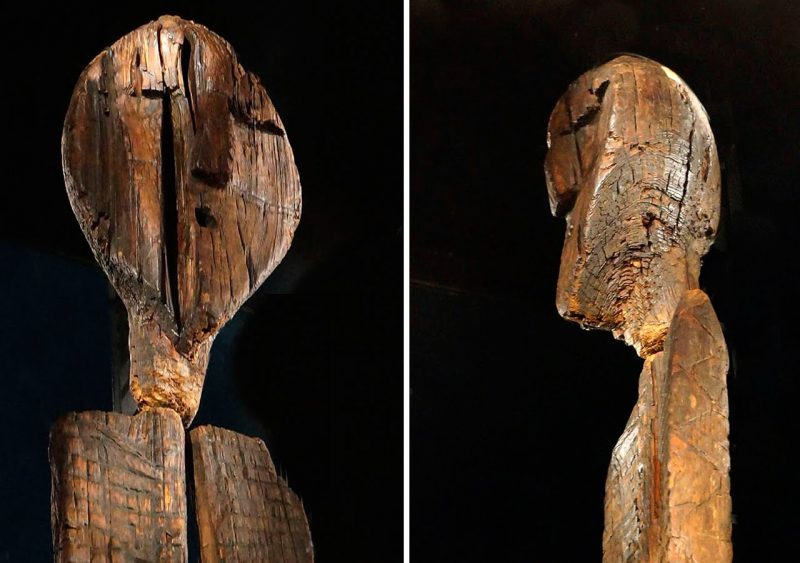The Shigir Idol is the world’s oldest wooden sculpture… but how old is it exactly?
Experts thought they knew. But a recent study reveals a fresh branch of information. The Idol is over twice the age of Stonehenge and pre-dates the Giza pyramids!
A little over 9 ft long, the Idol is a gangly, man-shaped arrangement of elements. It’s made from “a great slab of freshly cut larch”, as described by The New York Times.
Adorning it are geometric patterns, together with 8 faces. The head “projects authority, possibly malevolent authority” according to archaeologist Thomas Terberger. He’s been exploring the Idol for years and published the study with his co-authors in the journal Quaternary International.
The team have concluded the Idol is 12,100 years old – trumping Stonehenge and Giza by approx 7,000 years, based on numbers from Live Science.

Before that it was thought to be around 11,600 years old writes Ancient Origins. This previous assessment was made in 2018, though the Mesolithic artifact has been speculated on since 1997. Radiocarbon dating was used back then.
Accelerator mass spectrometry established more about the Idol in 2014, as mentioned by the Times. The complex business employed principles of nuclear physics to examine the sculpture on an atomic level.
Going by rings in the wood, a 159 year old tree was felled for the Idol. A spoon-like tool made of stone fashioned the raw material, according to Ancient Origins.
How did the latest look at this ancient wonder peel back the layers? Apparently modern day preservation led to distraction. The team reckoned “the use of wax and wood pigments in the treatments would have impacted the radiocarbon dates” from earlier investigations.
This meant the Idol would “appear younger than it really was.” By exploring untreated samples, they were able to work out the true age.
How did these latest findings come about…? Through a desire to make the Idol legitimate in the eyes of modern archaeology. Because its sophisticated style appeared at odds with ideas about the culture in those days, the Idol wasn’t taken too seriously. Some went as far as to call it a fake.
Ancient Origins notes ritual art on the Idol was “more diverse than the animal images and hunting scenes” associated with the Mesolithic Period, also referred to as the Middle Stone Age.
Discovering more about the sculpture’s roots means changes in perception for lofty experts. Just as Netflix movie ‘The Dig’ depicted archaeologists’ scepticism over the Sutton Hoo hoard and who made it, so Terberger and co have labored to reveal the true value of their artifact.
The Shigir Idol is all the more remarkable for the state in which it was found among the Ural Mountains, Siberia. Miners searching for gold in the Shigir peat bog – hence the sculpture’s name – dragged the fragments out of the muck over 100 years ago. It lay 13 ft under the surface.

The conditions kept the Idol in the archaeological equivalent of showroom condition. Peat has been very helpful to history hunters over the centuries!
What maybe wasn’t so helpful was handing the pieces to a local enthusiast, Dmitry Lobanov. As reported by the New York Times, Mr Lobanov reassembled the Idol for the world – but it wasn’t till later that the sculpture rested in a more accurate and complete pose. He surely did his best, but his day job as a railroad stationmaster meant he didn’t have the right skills for the task in hand.
Who or what is the sculpture based on? As noted by Ancient Origins, the Shigir Idol’s “high cheekbones and straight nose may reflect what the creators looked like”.
The study’s co-author Svetlana Savchenko notes similarities between the Shigir Idol and the planet’s oldest place of the worship, the Göbekli Tepe. Ultimately however the significance of the sculpture isn’t known.
Another Article From Us: Huge Bronze Age Spearhead Found – Rare Item Now on Display
Unlocking the Idol’s secrets is the next step, and a far from small one. Is it a record of changing times for ancient peoples? Did they bow down before it? Or could it be something else altogether? Currently based at the Sverdlovsk Regional Museum of Local Lore, Russia, people can go and make up their own minds once pandemic restrictions are lifted…
